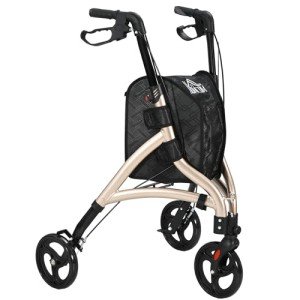The Comprehensive Guide to Rollator Walkers
As the population ages, the demand for mobility aids like rollator walkers has actually surged. These walkers provide stability, assistance, and flexibility of motion for people handling mobility issues, be they temporary or persistent. Understanding the kinds of rollator walkers available, their benefits, features, and how to choose the ideal one can considerably enhance the quality of life for both the user and their caregivers.
What is a Rollator Walker?
A rollator walker is a mobility aid designed to help individuals maintain their independence while walking. It includes a frame with four wheels, hand brakes, and a seat, making it suitable for users needing additional assistance without the full constraints of standard walkers.
Secret Features of Rollator Walkers
Rollator walkers come geared up with numerous functions designed to enhance user experience. Here are some of the most common functions:
- Four-Wheel Design: The most distinguishable feature is its 4 wheels, which permit smoother transitions over numerous surfaces.
- Padded Seat: Many rollators come with an integrated seat, supplying a resting point for users who may tire quickly.
- Hand Brakes: Most models have hand brakes that permit users to secure the walker in location when sitting or browsing irregular surface areas.
- Storage Options: Many rollators include a basket or storage pouch for personal items, such as water bottles or small bags.
- Adjustable Height: Users can tailor the height of the deals with for ideal convenience and posture.
Benefits of Using a Rollator Walker
Rollator walkers offer numerous advantages. They can considerably improve mobility and safety for users. Here are some essential benefits:

- Enhanced Stability: With four wheels and a sturdy frame, rollators supply exceptional stability compared to basic walkers.
- Convenient Seating: The integrated seat allows users to rest whenever required, promoting longer getaways without fatigue.
- Increased Confidence: The included support can help users feel more protected during strolls, which can lead to longer distances took a trip.
- Improved Posture: With adjustable heights, users can keep a more natural posture while walking, which can lower discomfort.
- Self-reliance: Rollators make it possible for many people to gain back or keep self-reliance in their everyday activities.
Kinds Of Rollator Walkers
Rollator walkers are available in different designs and variations to satisfy individual needs. Here are a few typical types:
| Type | Description |
|---|
| Standard Rollator | Basic four-wheeled design designed for indoor and outdoor use. |
| Junior Rollator | A smaller sized variation tailored for shorter individuals or kids. |
| Heavy-Duty Rollator | Constructed to accommodate larger body weights and provide extra stability. |
| Three-Wheel Rollator | Compact style ideal for navigating tight spaces. |
| Rollator with Seat | Features an integrated seat for resting throughout use. |
| Rollator With Storage (Solidfoundationestates.Com) | Comes with removable baskets or pouches for simple transportation of individual items. |
Picking the Right Rollator Walker
Picking the ideal rollator walker involves considering user needs, preferences, and physical requirements. Here are some factors to think about:
- User Height and Weight: Ensure the walker can support the individual's weight and can be adapted to their height.
- Surface: Consider where the walker will mainly be used. Detachable wheels can assist move efficiently over rough surfaces.
- Storage Needs: Determine if extra storage area is essential for the user's everyday requirements.
- Mobility: If regular transportation is necessary, lightweight models or those that fold for easy storage ought to be preferred.
- Spending plan: Prices can vary significantly; ensure the picked walker provides worth without sacrificing quality.
Maintenance of Rollator Walkers
Correct upkeep can enhance the life-span of a rollator walker. Here are some ideas for keeping it in good condition:
- Regular Check-ups: Periodically check brakes and wheels for wear and tear.
- Tidy the Walker: Use a moderate detergent and fabric to clean down surface areas and get rid of dirt.
- Inspect for Loose Parts: Tighten any screws or bolts that might become loose with regular use.
- Replace Parts as Needed: Wheels, hand grips, and brakes can break and might need replacement for optimal performance.
FAQs About Rollator Walkers
Q1: What is the typical weight limit for a rollator walker?A: Most standard rollator walkers support weights between 250 to 300 pounds, while durable designs can accommodate approximately 500 pounds. Q2: Can rollator walkers be utilized outdoors?A: Yes, lots of rollatorsare created for outdoor use. Those with
larger wheels and robust frames are especially fit for irregular surface areas. Q3: Do rollator walkers come with warranties?A: Many makers supply service warranties varying from 1to 5 years on the frame and parts, guaranteeing durability and user complete satisfaction. Q4: How do I effectively change a rollator walker?A: Adjust the handles to a height that permits the user to stand upright withelbows somewhat bent when holding the handles. Q5: Can
I use a rollator walker for rehabilitation?A: Yes, rollators are typically utilized in rehab settings to enhance walking confidence and mobilityafter injuries or surgeries. Rollator walkers
are invaluable tools that provide improved mobility and self-reliance for numerous individuals. By understanding the types, benefits, and appropriate use of rollatorwalkers, users can make informed decisions that best match their lifestyle and requirements. Whether recuperating from an injury or handling a long-term condition, a rollator walker can make a substantial difference in the lifestyle, enabling individuals to restore their liberty and confidence while moving about the world.